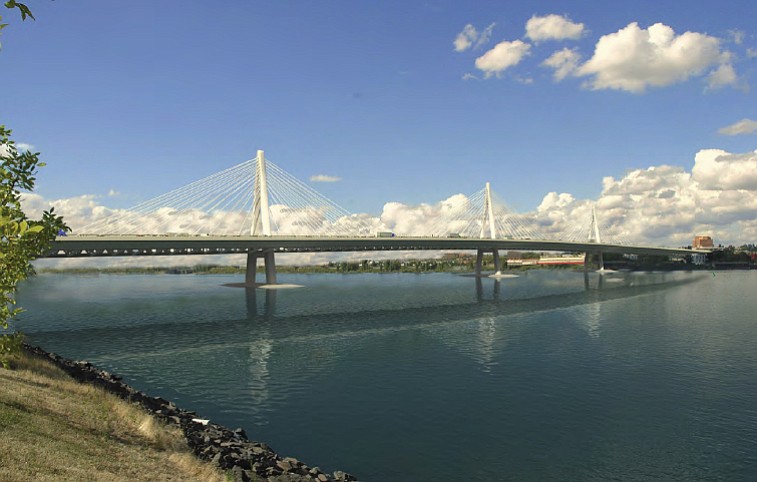For a history of the bridge project and previous news coverage, visit The Columbian’s I-5 Bridge Project page.
Govs. Chris Gregoire and John Kitzhaber have agreed with a bridge expert review panel’s recommendation to kill the current design for a new Interstate 5 bridge across the Columbia River.
The old design had been derided for its beached-aircraft-carrier appearance, as well as its high cost and questionable durability.
“We have instructed executives at the Departments of Transportation to discontinue any further design work on the open web box girder bridge type and begin an expedited review of the three bridge types developed by the panel,” the governors said in a joint statement.
The Bridge Expert Review Panel forwarded three alternative designs: A tied arch bridge, cable-stay and a composite deck truss structure that actually appears similar to the old CRC design.
“All three of these bridges are cheaper than the current open web,” panel chairman Tom Warne said in a telephone interview late Thursday.
He said that’s largely because the 16-member panel effectively straightened the river crossing from the sweeping downstream curve previously envisioned by project planners. He said each of the three alternatives is shorter than the CRC’s old design and each requires fewer bridge piers in the water.
“These are better solutions from many, many standpoints,” Warne said.
The panel estimates the composite deck truss bridge would cost about $100 million less than the CRC’s old open web box girder design. The cable-stayed bridge would be about $40 million cheaper and the tied arch design would cost $10 million less, Warne said.
However, the cable-stay and tied arch designs would require Federal Aviation Administration approval to impinge on the airspace of nearby Pearson Field.
Until now, that idea had been a nonstarter with project staff.
“The biggest constraint is the airspace from Pearson,” said Don Wagner, the co-director of the project for Washington. “We’ll have to find out whether you could actually intrude into the airspace.”
All three of the proposals include the required 95-foot clearance for passing ships
Warne said the arch and cable-stay designs would require a straighter alignment across the river than would the composite-deck truss design. Wagner said the straighter alignment would force engineers to either bend the freeway in a much tighter curve at each end of the span or do the opposite — flare out the freeway’s curve on land.
Wagner said a wider freeway curve “would maybe impact a few more buildings in downtown Vancouver.”
That may be a tough sell in Vancouver, where city officials have become increasingly wary of the new bridge’s looming presence on the revitalizing downtown. Mayor Tim Leavitt said he wanted to review the report before commenting on its recommendations.
A bridge alignment upstream from the current span would provide a naturally straight alternative. Washington-based bridge architect Kevin Peterson has been advocating the upstream alignment as a cleaner alternative, but it would put the span closer to the Fort Vancouver National Site.
“We ruled out upstream because of potential historic properties and protected Native American sites that could possibly be there,” Warne said.
Currently estimated to cost $3.6 billion, the entire CRC project would replace the two existing three-lane drawbridges across the river with 10 lanes, revamp seven interchanges along five miles of freeway, and extend Portland’s light-rail transit system into downtown Vancouver.
Project planners anticipate a three-way cost split among the federal government, the two states and local revenue generated by bridge tolls.



